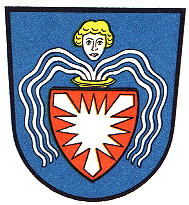Bornhöved: Difference between revisions
Knorrepoes (talk | contribs) No edit summary |
Knorrepoes (talk | contribs) m (Text replace - "[[Literature" to "{{media}} [[Literature") |
||
| Line 22: | Line 22: | ||
Bornhöved was an important meeting point for the nobility of Holstein in the 14<sup>th</sup> century and probably received some form of town or city rights in the 15<sup>th</sup> century. The only historical seal of Bornhöved dates from the 15<sup>th</sup> century and shows a head with a fountain. These symbols are canting, the name is derived from Born=spring and Höved=head. Below the fountain were the arms of the Counts of Holstein. This composition was finally granted as official arms in 1948. | Bornhöved was an important meeting point for the nobility of Holstein in the 14<sup>th</sup> century and probably received some form of town or city rights in the 15<sup>th</sup> century. The only historical seal of Bornhöved dates from the 15<sup>th</sup> century and shows a head with a fountain. These symbols are canting, the name is derived from Born=spring and Höved=head. Below the fountain were the arms of the Counts of Holstein. This composition was finally granted as official arms in 1948. | ||
{{media}} | |||
[[Literature]] : Stadler, K. : Deutsche Wappen - Bundesrepublik Deutschland. Angelsachsen Verlag, 1964-1971, 8 volumes. | [[Literature]] : Stadler, K. : Deutsche Wappen - Bundesrepublik Deutschland. Angelsachsen Verlag, 1964-1971, 8 volumes. | ||
Revision as of 19:13, 8 July 2014
| Heraldry of the World Civic heraldry of Germany - Deutsche Wappen (Gemeindewappen/Kreiswappen) |
BORNHÖVED
State : Schleswig-Holstein
District (Kreis) : Segeberg
Amt : Amt Bornhöved
Official blazon
In Blau der freischwebende holsteinische Wappenschild (in Rot ein silbernes Nesselblatt), auf dessen oberem Rand ein schwarzes flaches Gefäß (Quelleneinfassung) steht, aus dem nach rechts und links je drei lange Wellenlinien sich an beiden Seiten des Nesselblatts herunterziehen. Über der Quelle ein schwebendes goldgelocktes Menschenhaupt.
Origin/meaning
The arms were officially granted on May 15, 1948.
Bornhöved was an important meeting point for the nobility of Holstein in the 14th century and probably received some form of town or city rights in the 15th century. The only historical seal of Bornhöved dates from the 15th century and shows a head with a fountain. These symbols are canting, the name is derived from Born=spring and Höved=head. Below the fountain were the arms of the Counts of Holstein. This composition was finally granted as official arms in 1948.
Contact and Support
Partners:
Your logo here ?
Contact us
© since 1995, Heraldry of the World, Ralf Hartemink 
Index of the site
Literature : Stadler, K. : Deutsche Wappen - Bundesrepublik Deutschland. Angelsachsen Verlag, 1964-1971, 8 volumes.











